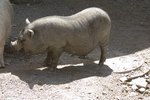
Though the mating habits and biology of birds varies by species, certain behavioral and physical attributes are virtually universal. When it comes to mating, this means the way males impregnate females is generally the same from species to species, despite minor variations. Typically, avian reproductive habits are considerably different from those of mammals, right down to the organs that make it all possible.
Reproductive Organs
While birds have the same internal organs that allow creatures like humans to conceive, such as testes and ovaries, one organ is often conspicuously absent: the penis. In most species, males do not have penises, and their testes are housed deep inside the body rather than in a dangling scrotum. This means that, from the outside, males and females frequently indistinguishable by their genitals, and must be identified by other physical markers like color patterns. While females produce their eggs via an ovary, they generally only have one -- the left ovary -- rather than two.
Mating Habits
The behavior leading up to mating and conception also varies by species, and some may be highly discriminating. Some species of bird, like budgies, pair off for life and remain monogamous, while others are promiscuous. Budgies also demonstrate how certain types of bird may be particular about where and when they mate, as they have distinct mating seasons and prefer to copulate in private areas. In the wild, this includes places like hollow logs and trees, while in captivity, it may necessitate the use of a nesting box.
The Cloacal Kiss
Because most birds do not have penises, the sex act and consequent conception are slightly different than in a mammal. They release sperm from the cloaca, a small posterior opening. Females also have a cloaca, which they use to receive sperm. Copulation is non-penetrative, and lasts only a few seconds. This act, colloquially known as the "cloacal kiss," is when a male mounts a female, twisting his tail beneath hers and lining up their cloacae so he can inseminate her. His sperm fertilizes the egg produced by her ovary, after which her body coats it in its protective shell.
Post-Conception Behavior
Though conception takes place inside the female's body when her egg is fertilized, the chick has not technically been born. After the egg receives its shell inside the female's body, she expels it from her cloaca, a process which can take just a few seconds or several minutes. The fleshy oviduct just inside her cloaca expands and contracts to prevent the egg from being contaminated by feces or other bodily waste that may cling to the cloaca, so the egg is laid clean and sanitary. The embryo matures inside the egg, which is incubated by one or both of the parents, until it has developed enough to hatch and survive in the open air.
References
Photo Credits
-
Jupiterimages/Photos.com/Getty Images
Writer Bio
Tom Ryan is a freelance writer, editor and English tutor. He graduated from the University of Pittsburgh with a degree in English writing, and has also worked as an arts and entertainment reporter with "The Pitt News" and a public relations and advertising copywriter with the Carnegie Library of Pittsburgh.




